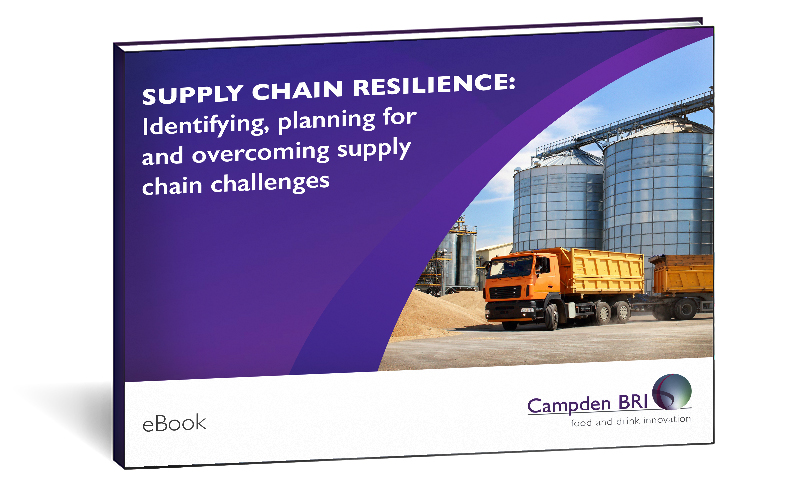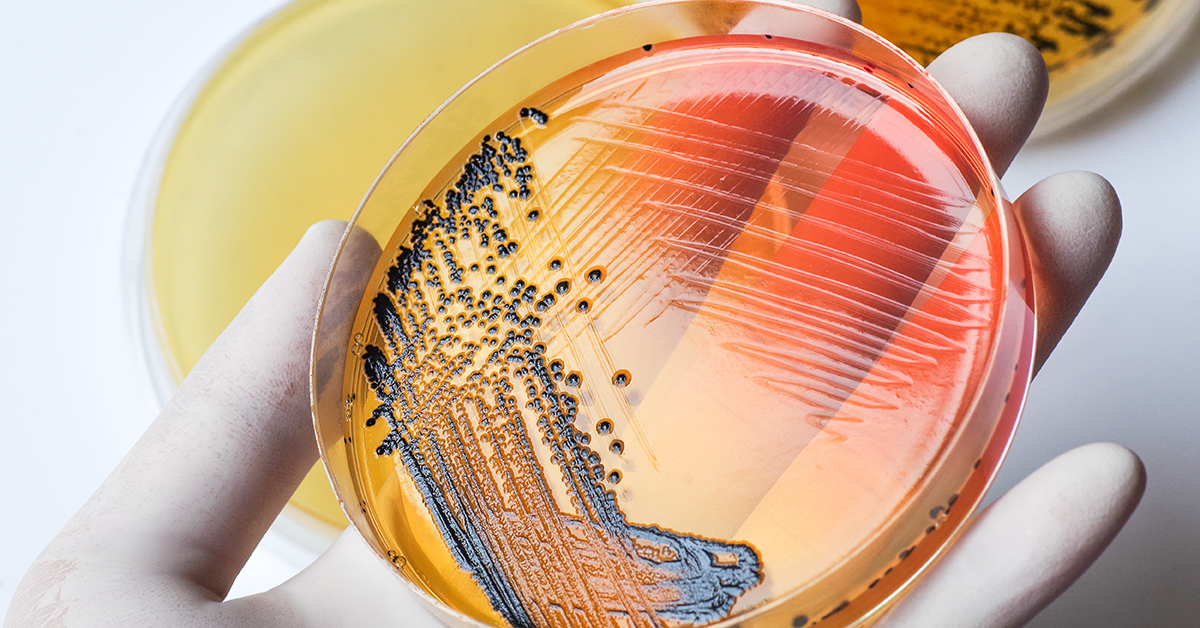
Pathogen risks to be aware of – lessons from recent recalls and outbreaks
17 November 2023 | Suzanne Jordan, Section Lead - Molecular Microbiology and Methods
The growth of the food and drink industry means that its global revenue is set to reach 11.1 trillion US dollars by 2026. Whilst there are social and economic benefits with the increase in food trade it also makes the spread of illness around the world easier.
Alongside industry growth, there are a number of drivers for outbreaks, both of common and emerging pathogens of concern. Drawing on recent outbreak and recall information, this blog provides an overview of the foodborne pathogens of concern in the food chain and food processing environment, including what we can learn in terms of the risks to be aware of.
Download our FREE Supply Chain Resilience eBook today! Thrive in a changing environment by being prepared, agile and resilient.

Drivers for outbreaks and pathogens of concern
Within our food system, there are a number of drivers for outbreaks of pathogens of well established concern, as well as the emergence of new / emerging pathogens. Many of these drivers are linked to changes in consumer demand.
These drivers for pathogen outbreaks and recall numbers include:
- Increase in ingredients sourced from the global food supply chain (buyers looking further afield due to cost and availability pressures)
- Rise in production of ready-to-eat (RTE) food products (higher microbiological risk than ready-to-cook), requiring more processing steps during manufacture
- Pressures to produce clean label and minimally processed products, potentially removing ‘hurdles’ (hurdle technology; using a combination of factors that each prevent or slow microbial growth)
- New product and ingredient categories (such as plant-based products and alternative protein sources) as well as new farming and manufacturing processes (such as precision fermentation, vertical farming and hydroponics)
- Availability of standardized methods and improvements in methodology for pathogens (a perceived increase in outbreaks due to the identification and successful investigation of outbreaks that would have perhaps previously gone undetected or without a cause identified)
Recent outbreaks and recalls
Whilst these actors within our food system may drive changes to some of the specifics that we need to consider when identifying and mitigating the risks that pathogens pose to our end products, the main contamination routes / sources remain the same – the agricultural environment and the processing / production environment. As the following recent outbreak and recall examples show.
Listeria monocytogenesrelated recalls of dairy, dried meat and RTE products
Listeria monocytogenes– widespread in the environment and able to grow at chilled temperatures, relatively low pH and high salt concentrations – causes the foodborne illness listeriosis. Listeriosis has a relatively high mortality rate of 30%, and at-risk groups include those who are immuno-suppressed, pregnant and/or elderly.
RASFF (the EU ‘Rapid Alert System for Food and Feed’) recalls relating to Listeria were high for dairy products in 2023 compared to previous years, and many Listeria-related RASFF recalls for meat in 2023 related to dried meat products. Recent RASFF recall data also shows a high level of recalls relating to the presence of Listeria monocytogenes in ready-to-eat (RTE) products.

Salmonella contamination from the food production environment
Salmonella is the second most common cause of foodborne gastroenteritis in UK and Europe. It can be isolated from a wide selection of food types, can survive in dry environments / dry food products, and its heat resistance is known to increase in dry environments.
The RASFF website shows 2020/21/22 instances of Salmonellosis outbreaks thought be associated with environmental contamination. These include: a worldwide Salmonella Typhimurium outbreak linked to Chocolate products in 2022 (found to be linked to hygiene / cleaning issue relating to a filter on a buttermilk tank); a Salmonella Enteritidis outbreak in Italy 2020, linked to raw sheep milk cheese (issues reported with milk and farm hygiene); a 2021 Salmonella Typhimurium outbreak in the USA linked to hydroponically grown fresh produce (exact source of the contamination was not confirmed, although the growth medium was found not to be protected from external contamination, and Salmonella Liverpool isolated from production pond).
Hydroponics and vertical farming are growing areas of the food industry, with start-up companies being created using these and other new production processes / technologies. Like for all feed, food and drink production operations, environmental contamination risks are something that need to be considered for new manufacturing processes, especially as they may have unique and / or different risks compared to well-established and even similar processes.
As well as changes to the food industry itself in terms of farming and manufacturing methods, there is also the impact of climate change to consider. The prevalence of Salmonella in the environment is increased in elevated temperatures and heavy rainfall. The effect of climate change on the agricultural environment, and therefore on foodborne pathogens, could therefore increase the risk of food contamination from the agricultural environment and instances of Salmonellosis.
Bacillus cereus risk from herbs/spices and alternative protein sources
Bacillus cereus produces spores that are more resilient than vegetative cells, and is known to be present in soil (and is therefore a potential environmental contaminant of crops). The vegetative cells produce two types of toxin – emetic (relatively heat stable) and diarrhoeal. Illness caused by Bacillus cereus is typically linked to consumption of starchy foods, including rice.
The product category with associated with the highest number of recent RASFF recalls relating to Bacillus cereus contamination was the herbs and spices category (herbs and spices imported into the EU). Dry products / ingredients such as herbs and spices can, when contaminated with Bacillus cereus spores, pose a risk once combined into recipe, because moisture will enable the spores to germinate and the resultant vegetative cells to produce illness-causing toxins.
RASFF recall data relating to Bacillus cereus contamination shows that it has been isolated from alternative protein sources, such as insects and plant analogue products. It may be that the established practices and processes used to manage / overcome Listeria risk in meat products may not be applicable or effective for their plant-based / alternative protein counterparts. The recent emergence and growth of the plant-based / alternative protein categories could potentially therefore lead to the emergence of more Bacillus cereus incidents.
The emergence of parasite outbreaks – Cryptosporidium, Cyclospora and Giardia
Cryptosporidium spp. and Cyclospora spp. and Giardia are all parasites present in recreation water and in the gastrointestinal tract of domestic and wild animals. In their cyst /oocyst form they are relatively resistant to chlorine. Sources of foodborne contamination with these parasites include contaminated water and infected food handlers with poor hygiene.
In 2021, there was an outbreak of Cryptosporidium parvum linked to an on site farm vending machine at a farm in South West England – processed milk in this vending machine was the common link between patients. A calf on site was found to have the presence of the same serotype of Cryptosporidium parvum as that found in human samples. High levels of Enterobacteriaceae were also present in swabs taken from milk from the same vending machine, which was indicative of post process contamination as a potential cause of the outbreak. In 2022, there were 2 recorded outbreaks of Cyclospora cayetanensis, where patients reported eating leafy greens, but no source was identified. Fresh produce has also been linked to prior outbreaks.
Whilst the 14 day incubation for illness from these parasites can make identifying and investigating outbreaks challenging, there are now new methods available to test for these microorganisms. It is likely that this relatively new heightened ability to test for / link these parasites to foodborne illness is a driver in the increased number of recalls seen for these microorganisms.
The next progress step for the industry may be to develop and validate effective methods for decontaminating fresh produce with respect to parasites such as Cryptosporidium, Cyclospora and Giardia.
Where infections affect staff members in food production facilities, an effective return to work is important to prevent spread to colleagues and contamination of the production environment and product.
Norovirus; policies and procedures for managing the risk to product
Norovirus – a highly infectious virus, which causes seasonal outbreaks with gastrointestinal symptoms – can survive for long periods at low pH and reduced water activity (via various solutes). Transmission can be via food products as well as person-to-person, which can make foodborne causes harder to identify and investigate.
Many of the outbreak / recall examples shared in this blog relate to food products themselves (or contamination from the agricultural environment) being the source of the microorganisms, whereas Norovirus risk relates to contamination of food and drink products by virus present on food contact surfaces and in the production environment.
To effectively manage the risk posed by parasites, Norovirus and other infections, food business operators need a policy for food handlers / production operatives with gastroenteritis.
A suitable return to work policy is needed to ensure the effective management of the risk from those infected.
An effective, validated, documented clear up procedure for decontamination is also paramount. With Norovirus, for e xample, high levels of virus particles in vomit can be aerosolized to cover greater distances away from the infected handler, making Norovirus a risk to the food production environment and associated food products.

Staphylococcus aureus presence on mobile phones; importance for food handlers
Staphylococcus aureus is present in the environment and in the nasal cavity or on skin of human carriers. As such, it is used as a hygiene indicator within finished food and drink products that can support its survival and growth. It produces relatively heat resistant toxin, but infections with Staphylococcus aureus are thought to be under reported due to fairly mild symptoms experienced.
A study carried out in Mexico to research the molecular characterization of S. aureus isolates present on mobile phones showed contamination of mobile phones with strains present in the nose and pharynx of owners.
Based on the findings, and that such devices are not regularly cleaned, the study highlights mobile phones as a possible source of contamination in food production environments. This is perhaps most relevant to the food service sector where hygiene of food handlers is key.
We are here to help
For existing products, product development and exploring new ingredient / product categories and manufacturing processes (whether they are new to you or new within the industry as a whole), we can help with product microbiological risk assessment and advising on optimal risk reduction strategies. If there is ever doubt that the correct hazards have been identified, then producers should contact an experienced food microbiologist that can help them in their ongoing quest to produce the safest foods with the lowest risk.
We can advise on your testing and methodology requirements for your specific situation and product, and can conduct microbiological testing, either for routine analysis, or analysis in response to a challenge or for investigations / troubleshooting.
When it comes to hygiene and preventing contamination from the food processing / production environment, we can support with hygienic design, cleaning and environmental monitoring plans (EMP). We can visit your site to provide practical support with proactive initiatives and troubleshooting alike. For example, we can help you to investigate and overcome the resistance and persistence of microorganisms, including biofilms.
For well established bacterial pathogens of concern as well as viruses, parasites and emerging threats, we develop, validate and help implement effective decontamination methods into client facilities. We also support clients with process control design / review, implementation, validation – from a microbiological / decontamination perspective and more broadly.

About Suzanne Jordan
Suzanne has worked here at Campden BRI since 2005, following nine years of PhD and postdoctoral research experience in food microbiology and molecular biology of food microorganisms.
Suzanne is the lead for third party microbiological method validation studies for AOAC, MicroVal and NordVal, is a Retailer-approved Method Review Co-ordinator, and is involved in several research and contract projects for developing and evaluating new methodology. Alongside this, she is an industrial PhD supervisor for a project on the of fine-tuning dietary fibre to target gut microbiota accessibility.
During her career to date she has participated in multidisciplinary research projects involving European partners, developed expertise in a range of molecular techniques, and presented her research at an international level and in peer-reviewed journals.
How can we help?
If you’d like support or information on controlling pathogen risks, contact our team to find out how we can help.
Download our FREE ‘Supply Chain Resilience’ eBook today!
Be resilient and thrive – ensure continuity of supply of safe, quality food.







